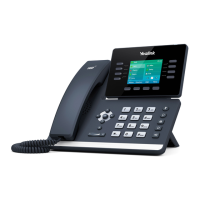Administrator’s Guide for SIP-T2 Series/T19(P) E2/T4 Series/T5 Series/CP860/CP920 IP Phones
1082
INVITE—User A to Proxy Server
User A sends a mid-call INVITE request to
the proxy server with new SDP session
parameters, which are used to place the
call on hold.
INVITE—Proxy Server to User B
The proxy server forwards the mid-call
INVITE message to User B.
200 OK—User B to Proxy Server
User B sends a SIP 200 OK response to the
proxy server. The 200 OK response
notifies User A that the INVITE was
successfully processed.
200 OK—Proxy Server to User A
The proxy server forwards the 200 OK
response to User A. The 200 OK response
notifies User B is successfully placed on
hold.
ACK—User A to Proxy Server
User A sends an ACK message to the
proxy server. The ACK confirms that User
A has received the 200 OK response. The
call session is now temporarily inactive.
No RTP packets are being sent.
ACK—Proxy Server to User B
The proxy server sends the ACK message
to User B. The ACK confirms that the
proxy server has received the 200 OK
response.
INVITE—User A to Proxy Server
User A sends a SIP INVITE request to the
proxy server. In the INVITE request, a
unique Call-ID is generated and the
Contact-URI field indicates that User A
requests the call.
INVITE—Proxy Server to User C
The proxy server maps the SIP URI in the
To field to User C. The proxy server sends
the INVITE request to User C.
180 Ringing—User C to Proxy
Server
User C sends a SIP 180 Ringing response
to the proxy server. The 180 Ringing
response indicates that the user is being
alerted.
180 Ringing—Proxy Server to
User A
The proxy server forwards the 180 Ringing
response to User A. User A hears the ring-
back tone indicating that User C is being

